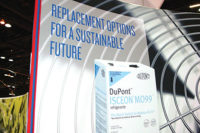At a meeting of the American Bakers Association Environmental & Health Committee, DuPont Market Information Manager Kevin O’Shea provided the group with perspectives gained by DuPont over more than 10 years of helping its customers transition away from ozone-depleting refrigerants. The key message: Any company trying to put together a strategy around alternative refrigerants would be well-served by using “The Six R’s of Refrigerant Management.”
DuPont established these guidelines when transitioning its own facilities away from CFC refrigerants during the early to mid-1990s. Earl Clark, who coordinated the conversion of DuPont-owned equipment, summed up the experience: “If you don’t plan your work, and then work your plan, you usually end up wasting both time and money.”
Here from DuPont are the six R’s to consider:
RULES
Knowing the rules your business is required to live by is where it all starts. Many companies have expressed surprise when asked by EPA auditors to produce their records showing compliance with Section 608 of the Clean Air Act. The records for leak history for equipment with more than a 50-lb refrigerant charge, technician certification, and refrigerant recovery equipment are among those that have sent companies scrambling. An EPA website that provides access to information to regulatory requirements for stationary air conditioning and refrigeration equipment can be found atwww.epa.gov/ozone/ title6/608/.REVIEW
Once you know the rules, it helps to review your equipment. Make a record of what refrigerant and lubricants are used, the maintenance history of the equipment, and your best assessment of remaining service life.REPAIR
If the equipment has been leaking refrigerant, you want to repair the leaks. Putting new refrigerant in a leaky bucket will not fix the bucket.RETROFIT
For equipment that is running well and has remaining service life, you need to determine your best option for retrofit. There are many products in the marketplace that promise a “quick fix,” but their claims may not always hold up.Key questions to ask when choosing a refrigerant for retrofit are:
REPLACE OR RETIRE
If you find the equipment has leaks that can’t be fixed, has a poor maintenance history, or has very low energy efficiency, it might make sense to replace or retire the equipment. If the cooling demand has changed significantly since the equipment was installed or redundant capacity is in place, then retiring the equipment might be the best option. Replacing the old, high-maintenance equipment can often provide significant energy and maintenance cost savings.Following an organized approach to refrigerant management can pay long-term dividends for you and your company. Once you’ve got a working plan in place, you might even have a chance to consider a seventh R: relax.
For more information, call 800-235-7882 or visit www.suvadupont.com (website).
Sidebar: The Six R’s
Rules — Know the rules you have to comply with.Review your equipment — Refrigerant, charge size, age, and maintenance history should be recorded.
Repair leaky equipment — Putting new refrigerant in a leaky bucket won’t fix the bucket.
Retrofit —Choose a refrigerant that will meet your performance needs in regards to such factors as cooling capacity, system durability, oem approval, and total cost of retrofit.
Replace old equipment — Replacing old, high-maintenance equipment can often provide significant energy and maintenance cost savings.
Retire the equipment — If cooling demand has been reduced significantly since equipment was first installed, you may be able to retire some of the older, less efficient equipment.
Publication date: 04/01/2002


